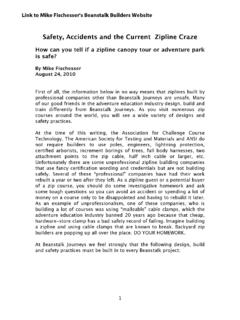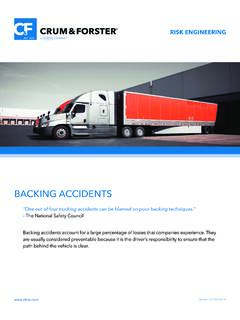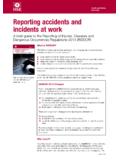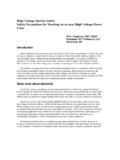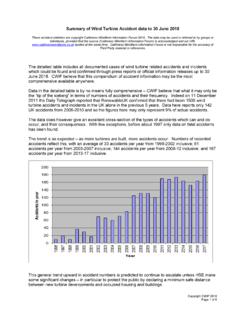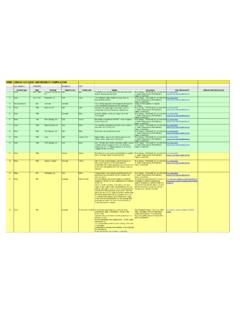Transcription of In Depth Study of Motorcycle Accidents
1 Road Safety Research Report No. 54 November 2004In Depth Study ofMotorcycle AccidentsISSN 1468-9138 Product code 045 RRLG02120/54 Road Safety Research Report No. 54In- Depth Study of MotorcycleAccidentsDavid D. Clarke, Pat Ward, Craig Bartle andWendy TrumanSchool of PsychologyUniversity of NottinghamNovember 2004 Department for Transport: LondonAlthough this report was commissioned by the Department for Transport, the findings and recommendationsare those of the authors and do not necessarily represent the views of the DfTDepartment for TransportGreat Minster House76 Marsham StreetLondon SW1P 4 DRTelephone 020 7944 8300 Internet service: #Queen s Printer and Controller of Her Majesty s Stationery Office in the typographical arrangement and design vests in the publication (excluding the Royal Arms and departmental logos) may be reproduced free of charge in anyformat or medium research, private Study or for internal circulation within an organisation.
2 This is subject to itbeing reproduced accurately and not used in a misleading context. The material must be acknowledged asCrown copyright with the title and source of the publication any other use of this material, please write to:HMSO, The Copyright Unit,St Clements House,2 16 Colegate, NorwichNR3 1 BQFax: 01603 723 000or email: for a reproduction should be made in writing to HMSO, The Copyright Unit,St Clements House, 2 16 Colegate, Norwich NR3 copies of this report are available from:Department for TransportPO Box 236 WetherbyWest YorkshireLS23 7 NBTel: 0870 1226 236 Fax: 0870 1226 237 Email: document is also available on the DfT website: by the Department for in Great Britain on material containing 75% post-consumer waste and 25% ECF pulp (cover) and 100%post-consumer waste (text).
3 November 2004 ISSN 1468-9138 Product code 045 RRLG02120 accident of way control on manoeuvrability Motorcycle of Motorcycle and engine and riding for using a and opinions regarding causes of Motorcycle is responsible for Motorcycle Accidents ? Safety Right of way manoeuvrability Motorcycle attitudes516 CONCLUSIONS547 REFERENCES56 APPENDIX59 The questionnaire59 Countermeasures67In- Depth Study of Motorcycle Accidents41 EXECUTIVE SUMMARYM otorcycle Accidents have somewhat different characteristics to Accidents involvingother classes of road user. In particular, they include right of way Accidents , Accidents involving loss of control on bends, and Accidents caused by motorcyclistsusing the more frequent overtaking and passing opportunities that this choice oftransport affords them.
4 Increases in scooter and Motorcycle sales in recent yearshave caused a corresponding increase in deaths and serious injuries caused to theirriders, following a period of relative decline. Scooters have seen a 16% rise in salesbetween 2002 2003; and recent licensing data for larger motorcycles (above 500ccengine capacity) shows that they now account for around half of all registeredmotorcycles, so this pattern seems set to sample of 1,790 accident cases was considered, including 1,003 in detail, fromMidland police forces, involving motorcyclists of all ages, and covering the years1997 2002 inclusive. Each case was summarised on a database including the mainobjective features (such as time and place) and a summary narrative, a sketch planand a list of explanatory factors.
5 The summary narrative, in particular, includedjudgements by the researchers that emphasised the sequence of events leading up tothe accident . In addition, a 25 item questionnaire was completed by a sample ofrelatively experienced motorcyclists recruited through the Motorcycle Action Group(MAG).Significant differences were discovered in the sample with respect to the types ofaccidents involving motorcyclists (and their blameworthiness). The main findingswere as follows: There seems to be a particular problem surrounding other road users perceptionof motorcycles , particularly at junctions. Such Accidents often seem to involveolder drivers with relatively high levels of driving experience who nonethelessseem to have problems detecting approaching motorcycles .
6 Motorcyclists themselves seem to have far more problems with other types ofaccident, such as those on bends, and overtaking or filtering Accidents . There are two main groups of riders that interventions should be focussed first is young and inexperienced riders of smaller capacity machines such asscooters, and the second is older, more experienced riders of higher capacitymachines. Both the skillsandattitudes of these riders need to be Motorcycle accidentsMotorcyclists have an especially poor safety record when compared to other roaduser groups. Their killed and serious injury (KSI) rate in the UK, per million vehiclekilometres, is approximately twice that of pedal cyclists and over 16 times that ofcar drivers and passengers.
7 Motorcyclists make up less than 1% of vehicle traffic buttheir riders suffer 14% of total deaths and serious injuries on Britain s roads (DETR,2000).26,192 motorcyclists (this figure includes moped and scooter riders) and pillionpassengers were injured in reported Accidents in Great Britain in 1999. 6,361 ofthese injuries were considered serious, and 547 motorcyclists and passengers werekilled. In the same year 205,735 car drivers and passengers were injured inaccidents. 18,681 of these injuries were considered serious, and 1,687 drivers andpassengers 1999 a motorcyclist was killed or seriously injured for every 665,894 kilometresridden. Car drivers, however, covered an average of 18,661,626 kilometres before aserious injury or death occurred.
8 According to these figures, in 1999 motorcyclistswere approximately 28 times more likely to be killed or seriously injured on theroads in Great Britain than car et al. (1993) compared distance travelled with injuries sustained and foundthat in 1990 a motorcyclist was 35 times more likely to be killed or seriously injuredthan a car driver. Although the figures have improved over the last 10 years, the riskfactor for motorcyclists when compared to car drivers is still very high. It isimportant to remember that, compared in an accident , a motorcyclist is much morevulnerable to personal injury than a car driver. Safety and accident avoidance formotorcyclists is therefore of paramount similar picture is given by research in other countries.
9 Motorcycle riders in NewZealand accounted for approximately 20% of fatalities and 25% of hospitalisationsfor road traffic Accidents as a whole, but motorcycles represented only 5% oflicensed vehicles and accounted for only of estimated total vehicle mileage inthat country (Reeder et al., 1999). Young male riders, in particular, were identifiedas a problem; riders aged 15 24 years accounted for 67% of all Motorcycle accidentfatalities. This led to the introduction of a graduated licensing scheme in NewZealand, which has reportedly reduced casualties in the target group of 15 19 yearolds by 22%, though this mainly occurred by reducing that groups overall exposureto Motorcycle in Norway by Kopjar (1999) investigated young riders moped Accidents ,the use of mopeds in that country apparently being relatively widespread in the 16 17 year old age group.
10 Kopjar discovered that moped-related Accidents accountedfor 50% of hospitalisations for traffic Accidents as a whole, and that 43% of mopedaccidents were single vehicle incidents. He concluded that moped injuries were aserious problem in late adolescence, and that road safety professionals oftenoverlooked the moped a fall in the amount of motorcycling and changes in Motorcycle training inthe UK both contributed to a fall in the number of motorcyclist casualties in theearly 1980s and mid-1990s, this trend has reversed in more recent years. Thepossible reasons for this include the increasing sales of mopeds and scooters: thenumber of motorcycles , scooters and mopeds that are newly registered has morethan doubled between 1991 and 2001, with over 177,000 being registered in is despite an earlier fall in registrations to below 59,000 in 1993.
